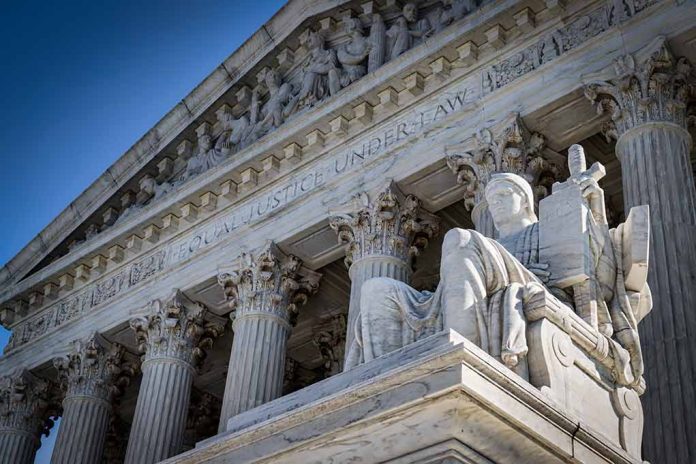
President Trump’s push to fire independent agency leaders now faces a Supreme Court challenge that could fundamentally alter the balance of executive power in the federal government.
Key Takeaways
- The Trump administration has asked the Supreme Court to allow the president to remove leaders of independent regulatory agencies, potentially affecting bodies like the Federal Reserve.
- Two specific cases involve Gwynne Wilcox of the National Labor Relations Board and Cathy A. Harris of the Merit Systems Protection Board, who were reinstated by lower courts after being removed.
- The cases challenge a 90-year-old Supreme Court precedent (Humphrey’s Executor v. U.S.) that has protected independent agency leaders from presidential removal.
- If successful, Trump’s legal challenge could significantly expand presidential authority and potentially reduce regulatory oversight across numerous federal agencies.
Trump’s Challenge to Agency Independence
President Trump has intensified efforts to assert control over federal bureaucracy by attempting to remove independent watchdogs and Democratic appointees from regulatory bodies. The administration’s legal challenge now before the Supreme Court focuses on the president’s authority to dismiss leaders of independent agencies who have statutory protections against removal. This effort specifically targets Gwynne Wilcox of the National Labor Relations Board and Cathy A. Harris of the Merit Systems Protection Board, both of whom were removed by Trump but later reinstated by lower courts while litigation continues.
The Trump administration argues that requiring a president to delegate executive power to agency heads who oppose administration policies undermines constitutional authority. Solicitor General D. John Sauer has taken a firm position, stating: “This situation is untenable. The President should not be forced to delegate his executive power to agency heads who are demonstrably at odds with the Administration’s policy objectives for a single day — much less for the months.”
The Humphrey’s Executor Precedent
At the heart of this legal battle lies the 1935 Supreme Court decision in Humphrey’s Executor v. U.S., which established job protections for independent agency leaders. This landmark ruling has stood for nearly nine decades, allowing Congress to create regulatory bodies with a degree of independence from presidential control. The Trump administration now argues this precedent unconstitutionally restricts presidential authority and should be overturned, potentially giving the White House unprecedented control over agencies that have traditionally maintained operational independence.
The judge in Wilcox’s case firmly rejected Trump’s interpretation, writing that the president’s “interpretation of the scope of his constitutional power — or, more aptly, his aspiration — is flat wrong.”
Trump asks Supreme Court to let him fire independent regulators https://t.co/u44Z8Fty6i
— @AcrossTheCurve (@acrossthecurve) April 9, 2025
Potential Consequences for Government Function
Legal experts warn that overturning Humphrey’s Executor would fundamentally alter federal governance. The administration’s push aligns with the “unitary executive theory,” which holds that the president should control all executive branch actions. If successful, Trump’s challenge could grant the White House unprecedented influence over agencies like the Federal Reserve Board, Federal Trade Commission, and Federal Communications Commission, potentially affecting monetary policy, consumer protection, and communications regulation.
“It would be a real earthquake in terms of the way our government operates. All these agencies that people may not think about have a real impact on people’s day-to-day lives,” said Brianne Gorod, an expert on the matter.
Recent Supreme Court Precedents
The Supreme Court has shown willingness to expand presidential authority in recent years. In 2020, the Court found the structure of the Consumer Financial Protection Bureau unconstitutional in the Seila Law decision, ruling that its single director with removal protections violated separation of powers principles. While that decision left Humphrey’s Executor standing, several conservative justices expressed interest in further limiting independent agencies’ autonomy.
Justice Elena Kagan’s dissent in the Seila Law case emphasized the importance of administrative independence, specifically highlighting agencies like the Federal Reserve Board that manage complex economic issues requiring expert, nonpartisan judgment. The current Court’s conservative majority may now have the opportunity to reconsider the constitutional foundation for independent regulatory agencies and potentially grant President Trump greater authority to remove agency leaders who oppose his administration’s policy objectives.
Sources:
- Trump asks Supreme Court to let him fire independent regulators | Constitutional Accountability Center
- Supreme Court expected to consider giving Trump more firing power, overruling 90-year-old precedent | AllSides
- A 90-year precedent in danger: How Trump could gain unprecedented firing powers














